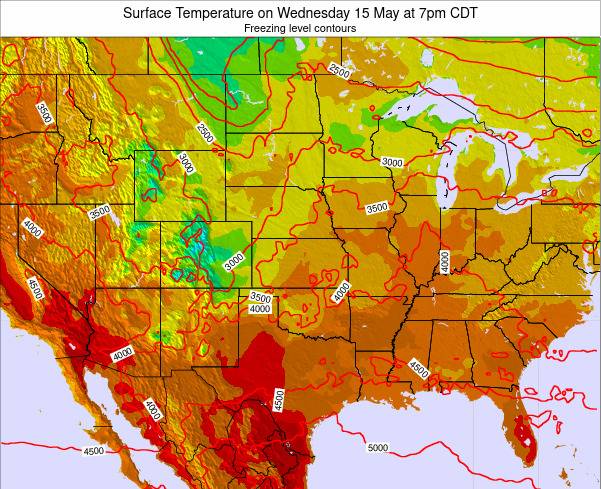
On the last day of October, sunrise is at 7:50 am and sunset at 6:36 pm CDT. On the first day of the month, sunrise is at 7:24 am and sunset at 7:14 pm. DaylightIn October, the average length of the day in Oklahoma City is 11h and 17min. SnowfallIn Oklahoma City, snow does not fall in May through October. In Oklahoma City, during the entire year, the rain falls for 121 days and collects up to 24.96" of precipitation. Throughout October, 2.36" of precipitation is accumulated. Rainfall In October, the rain falls for 9.7 days. HumidityThe average relative humidity in October is 64%. Throughout October, the average low-temperature records at a fresh 52.9☏. TemperatureOklahoma City in October demonstrates a small temperature transition, adjusting from an average high of a moderately hot 84.6☏ in September to a pleasant 71.2☏. Referring to temperatures, the city embarks on the cooling trend with high and low temperatures fluctuating from 71.2☏ to 52.9☏. It's an ideal time for extended outdoor activities, to bask in the pleasant fall climate before winter sets in. The city's climate during this month induces a sense of calm before the arrival of winter chills, making it one of the most pleasant months of the year. Characterized by crisper air and breathtaking foliage, October offers a respite from the preceding months of heat.
#Current temperature in oklahoma city full#
Lifeguards can give you advice on waves if you’re planning to go into the water.October brings the fall season in full swing to Oklahoma City. If the arrow is parallel to or pointing away from land, the wave height is likely to be lower

If the arrow points towards land, most of the waves’ power will reach It indicates how sheltered theīeach will be from these waves.

The arrow shows the average direction of the waves 1-2 miles out to sea. Lifeguards can give youĪdvice on waves if you’re planning to go into the water. Period (more than 10 seconds) means the waves at the beach may be more powerful. This is the average number of seconds between one wave and the next, 1-2 miles out to sea. Read more about calculating the expected height of the waves at the beach. Water, keep an eye on the waves to stop you or your belongings being swept away. Individual waves out to sea or at the beach can be higher than this number. This is the average height of the waves, 1-2 miles out to sea. 11 Extreme - Avoid being outside during midday hours. 8-10 Very high - Spend time in the shade between 11am and 3pm. 6-7 High - Seek shade during midday hours, cover up and wear sunscreen. 3-5 Moderate - Take care during midday hours and do not spend too much time in the sun unprotected. No risk of UV - It’s safe to stay outside. UV exposure index and the protection required to help keep you safe: The higher the percentage of humidity, the wetter it will feel outside. If there is a lot of water vapour, the humidity will be Humidity is the amount of water vapor in the air. Visibility measures the distance at which an object can be clearly seen. Read more about how wind will affect you at the beach. The number is the average wind speed.īeware of offshore winds if you are using inflatables, paddle boards or kayaks. If the arrow points from land to sea, the wind The arrow shows the direction of the wind (up is north).

The number represents the average wind speed expected at that time. The letters show the direction the wind is blowing The arrow shows the direction the wind is blowing. Strong winds are shown in bold for speeds of 29 mph or more.

Wind gust shows the highest wind speed that you should encounter at that time, as winds peak and Idea of how the temperature will actually feel at the time. You can see the temperature in Celsius orįeels like temperature considers other factors, such as wind speed and humidity. This number shows the air temperature for the time period. Sleet, snow, hail and drizzle) will fall from the sky at a certain time. Chance of precipitation represents how likely it is that rain (or other types of precipitation, such as


 0 kommentar(er)
0 kommentar(er)
